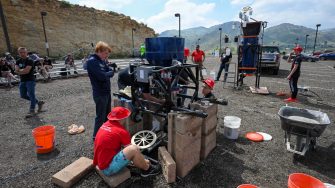Over the Moon! UNSW team celebrate third place in lunar dirt challenge
A team from UNSW Engineering have claimed third place in a prestigious international student competition to design and build a regolith transport solution for the Moon.
A team from UNSW Engineering have claimed third place in a prestigious international student competition to design and build a regolith transport solution for the Moon.

The "Over The Dusty Moon" challenge was hosted by Colorado School of Mines and Lockheed Martin in Denver, USA and featured five university teams from around the world.
The goal was to demonstrate systems designed and built for moving lunar dirt, or regolith, around the Moon’s surface. Judging focused on the amount of regolith simulant transported, system mass, energy consumed, dust tolerance and generation, autonomy and overall performance.
Each team was required to build a prototype that was able to transport lunar regolith between a hopper and a molten regolith electrolysis (MRE) plant located 5m apart.
The UNSW team’s submission was the Lunar Cable-Car Conveyance System or LCCS, taking inspiration from conventional cable-car systems used on Earth which are low weight, use very low power and can traverse rugged terrain unimpeded.
The LCCS used 14 canisters attached to a cable to transport the regolith, plus two simple mechanisms for filling and unloading.
After two days of competition, the UNSW team was placed third – behind winners from Laurentian University in Canada and runners-up from AGH University of Science and Technology in Poland – following deliberation by the judging panel which included technologists from NASA’s Kennedy Space Center and the Lockheed Martin Space division.
The LCCS project was initiated from the UNSW Engineering Design 2000 course, led by Dr Binghao Li, for the first phase. In the second phase two teams were added from the Vertically Integrated Projects, MINEX and MIOT, led by Dr Chengguo Zhang and Dr Binghao Li.
Dr Binghao Li said: "I am so proud of the team. They are predominantly second and third year students but did a great job. Their design was brilliant, light-weight, and low power consumption which is the best design for the real environment on the Moon."
LCCS team member Nick Barnett, a PhD candidate in Space Mining at UNSW, said: "International space agencies including the Australian Space Agency are looking at exploring the Moon, Mars and asteroids, and the only feasible way to do this is to utilise the resources available on these bodies.
“Transporting lunar regolith is an essential part of the extraction process. The environments which the systems need to operate in are unlike anything on Earth, with temperatures ranging from 120°C to minus 246°C, plus high levels of solar radiation, and soils that are jagged and very abrasive.”
"For an Australian team to make the finals of an international competition like Over the Dusty Moon challenge, it provides a platform for the Australian space and mining communities to work together and develop the next generation of engineers who will be working in space."
The UNSW Over the Dusty Moon team: Ramanan Mathisuthanan, Shiran Elilvathanan, Peter Johnson, Runzhe Hu, Yamin Ahmed, Seonik Cho and Nick Barnett.
UNSW aerospace engineering student Peter Johnson believes the hardest part of the competition was building the system.
"Designing a system in CAD is quite easy, however building it is far more difficult. The James Kirby and Elec Makerspace teams were instrumental in helping with the build, teaching the team essential manufacturing skills, and providing industry knowledge.”
Undergraduate mining engineering student Runzhe Hu explained that the challenge had been an incredible experience from start to finish.
“To be able to work alongside peers who have an endless passion for space mining, and to build a system that was only a concept several months ago, as well as meeting important people in the space mining industry – I could never have such an opportunity without this challenge,” he said.
“What I learned from this competition is to test, test, and test, and when you think you have tested enough, it is not enough. This was evident from the fact all the teams in the finals had an array of issues which needed to be overcome during the allotted time.
“Our team was able to overcome most of these problems through sheer persistence. One of the main learnings from the judges was that many of the systems will fail during a trail, regardless of how well a system has been tested beforehand."
Nick Barnett added that simplicity was the key for systems which are designed to be used on the moon.
"Due to the difficulty in performing maintenance operations on Off-Earth systems, they need to be reliable but also not overly complicated. Complicated systems have more things that can go wrong and are therefore seen as higher risk.
"The whole team did an amazing job designing and building the LCCS, and the results at Over the Dusty Moon challenge are reflected in that."
The UNSW student team was: Peter Johnson, Ramanan Mathisuthanan, Runze Hu, Seonik Cho, Shiran Elilvathanan, Syed Yamin Ahmed, Nicholas Barnett.
They were assisted by academics Dr Li and Dr Zhang, with industry support coming from Roobuck and Redwood who sponsored the team.